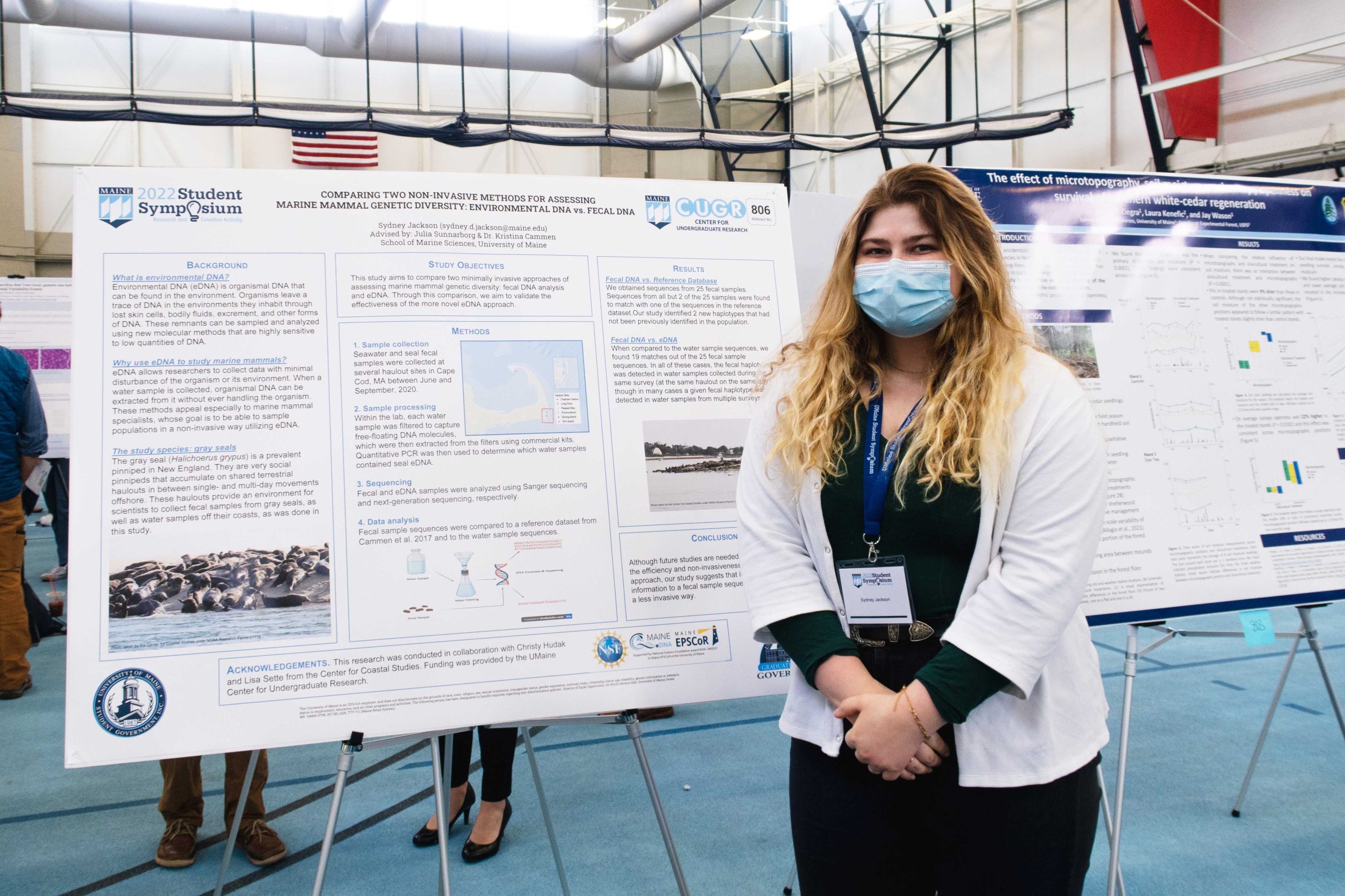
Maine-eDNA Undergraduate Student Sydney Jackson Tests eDNA Sampling Methods
By Caty DuDevoir, Maine EPSCoR Media Intern
Maintaining the natural state of an ecological community better informs future research and avoids disrupting the species that are present. Environmental DNA (eDNA) provides researchers with a cost-effective way to prevent significant invasion of an ecosystem while still being able to collect useful data. Determining the efficiency of eDNA compared to traditional data collection methods, such as blood or fecal collection, further advises researchers on the best techniques to use in the field. Sydney Jackson, who received her BS in Marine Science from the University of Maine in May 2022, “aimed to contribute to the already growing knowledge surrounding eDNA and the less invasive approaches to assessing marine mammal genetic diversity.”
Jackson joined the NSF EPSCoR RII Track-1 funded Maine-eDNA project as a research assistant in May 2021 and was advised by Kristina Cammen (Assistant Professor of Marine Mammal Science, UMaine School of Marine Sciences). While working with Maine-eDNA, Jackson had the opportunity to work closely with Julia Sunnarborg, a UMaine Marine Biology Ph.D. candidate based out of Orono, who studies the relationship between gray seal populations and their food sources in the Gulf of Maine (GoM) using eDNA.
Jackson’s interest in marine mammals and discussions with Cammen led her to participate in summer research with Maine-eDNA. “During my internship, I learned the foundations of eDNA, water filtering, and eDNA sampling for other projects through Maine-eDNA. When my senior year started, there were more hands-on opportunities with fecal samples and water samples to develop seal data.” As a member of the Honors College, the summer internship allowed Jackson to pursue her own independent research for her Honors thesis, entitled “Comparing Two Non-Invasive Methods for Assessing Marine Mammal Genetic Diversity Mammal Genetic Diversity: Environmental DNA vs. Fecal DNA.” With Sunnarborg’s and Cammen’s help, Jackson wrote a proposal that won fellowship funding from the UMaine Center for Undergraduate Research fellowship (CUGR). The grant assisted Jackson in gathering and analyzing eDNA water samples from various haul-out locations while supporting the Cammen lab’s research and Sunnarborg’s dissertation.
Prior to her independent research, Jackson noticed the lack of studies done to determine the benefits of eDNA to specifically study seal and pinniped populations. Water and fecal samples were collected from gray seal haul-out locations in Cape Cod, Massachusetts. Sunnarborg, Cammen, and Jackson worked closely together to analyze and understand the data from the haul-out sites. “eDNA was a major focus of the research, but we also had fecal analysis as well. We compared these two processes of methodologies for understanding marine mammal populations, specifically pinnipeds and gray seals,” stated Jackson, “We were essentially trying to confirm that eDNA was as efficient, if not more efficient, at detecting these populations. Hopefully, we can use the eDNA method for future monitoring because it is much less invasive.”
Ultimately, Jackson’s data found that eDNA does provide similar data results to fecal matter. Jackson explained, “eDNA can provide similar information like fecal DNA analysis. There are still a lot more studies that need to be done, but we did see a significant overlap which is great.” The Honors College at UMaine awarded Jackson the distinction of highest honors for her thesis, and Jackson had the opportunity to present her research at the UMaine Student Symposium in April. Having graduated this spring, Jackson plans to pursue a career in science journalism and continue working with marine mammals.
